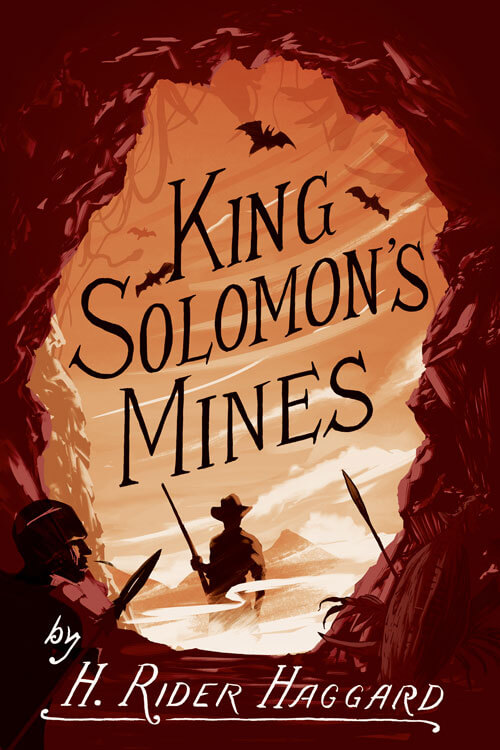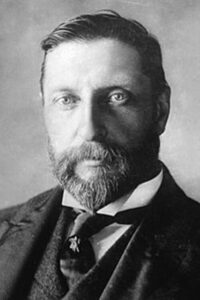
King Solomon’s Mines
The officer’s name I found out—by referring to the passengers’ lists —was Good—Captain John Good. He was broad, medium height, dark, stout, and a curious man to look at. He was so neat and clean-shaven, and he always wore eyeglasses in his right eye. It seemed to grow there, for it had no string, and he never took it out except to wipe it. At first, I thought he used to sleep in it, but afterwards, I found that this was a mistake. He put it in his trousers pocket when he went to bed, together with his false teeth, of which he had two beautiful sets that, my own being none of the best, have often caused me to break the tenth commandment. But I am anticipating.
Soon after we got underway, the evening closed in, and foul weather came with it. A keen breeze sprung off the land, and a kind of aggravated Scotch mist soon drove everybody from the deck. As for the Dunkeld, she is a flat-bottomed punt, and going up light as she was, she rolled very heavily. It almost seemed like she would go right over, but she never did. It was pretty impossible to walk about, so I stood near the engines where it was warm and amused myself with watching the pendulum, which was fixed opposite to me, swinging slowly backwards and forwards as the vessel rolled and marking the angle she touched at each lurch.
Read or download Book
H. Rider Haggard
Sir Henry Rider Haggard KBE (22 June 1856 – 14 May 1925) was an English writer of adventure fiction romances set in exotic locations, predominantly Africa, and a pioneer of the lost world literary genre.
Biography.
He was also involved in land reform throughout the British Empire. His stories, situated at the lighter end of Victorian literature, remain famous and influential.
Life and career
Family
Henry Rider Haggard, generally known as H. Rider Haggard or Rider Haggard, was born at Bradenham, Norfolk, the eighth of ten children, to William Meybohm Rider Haggard, a barrister, and Ella Doveton, an author and poet. His father was born in Saint Petersburg, Russia, in 1817 to British parents.
A member of the Haggard family, he was the great-nephew of the ecclesiastical lawyer John Haggard, an uncle of the naval officer Admiral Sir Vernon Haggard, and the diplomat Sir Godfrey Haggard.
Education
Haggard was initially sent to Garsington Rectory in Oxfordshire to study under Reverend H. J. Graham. Still, unlike his elder brothers, who graduated from various private schools, he attended Ipswich Grammar School. This was because his father, who perhaps regarded him as somebody who would not amount to much, could no longer afford to maintain his expensive private education. After failing his army entrance exam, he was sent to a private crammer in London to prepare for the entrance exam for the British Foreign Office, where he never sat. During his two years in London, he came into contact with people interested in studying psychic phenomena.
Writing career
After returning to England in 1882, Haggard published a book on the political situation in South Africa and a handful of unsuccessful novels before writing the book for which he is most famous, King Solomon’s Mines. He accepted a 10% royalty rather than £100 for the copyright.
A sequel soon followed, entitled Allan Quatermain, followed by She and its sequel Ayesha, swashbuckling adventure novels set in the context of the Scramble for Africa (although Ayesha’s action happens in Tibet). The hugely popular King Solomon’s Mines is sometimes considered the first of the Lost World genre. She is considered one of the classics of imaginative literature, and with 83 million copies sold by 1965, it is one of the best-selling books in history. He is also remembered for Nada the Lily (a tale of adventure among the Zulus) and the epic Viking romance Eric Brighteyes.
Legacy
Psychoanalyst Carl Jung considered Ayesha, the female protagonist of She, to be a manifestation of the anima. Her epithet “She Who Must Be Obeyed” is used by British author John Mortimer in his Rumpole of the Bailey series as the lead character’s private name for his wife, Hilda, before whom he trembles at home (even though he is a barrister with some skill in court). Haggard’s Lost World genre influenced famous American pulp writers such as Edgar Rice Burroughs, Robert E. Howard, Talbot Mundy, Philip José Farmer, and Abraham Merritt. Allan Quatermain, the adventure hero of King Solomon’s Mines and its sequel Allan Quatermain, was a template for the American character Indiana Jones. Quatermain has gained recent popularity thanks to being a main character in the League of Extraordinary Gentlemen.
In an essay about Haggard, Graham Greene stated, “Enchantment is just what this writer exercised; he fixed pictures in our minds that thirty years have been unable to wear away.” Haggard was praised in 1965 by Roger Lancelyn Green, one of the Oxford Inklings, as a writer of a consistently high level of “literary skill and sheer imaginative power” and a co-originator with Robert Louis Stevenson of the Age of the Story Tellers.






